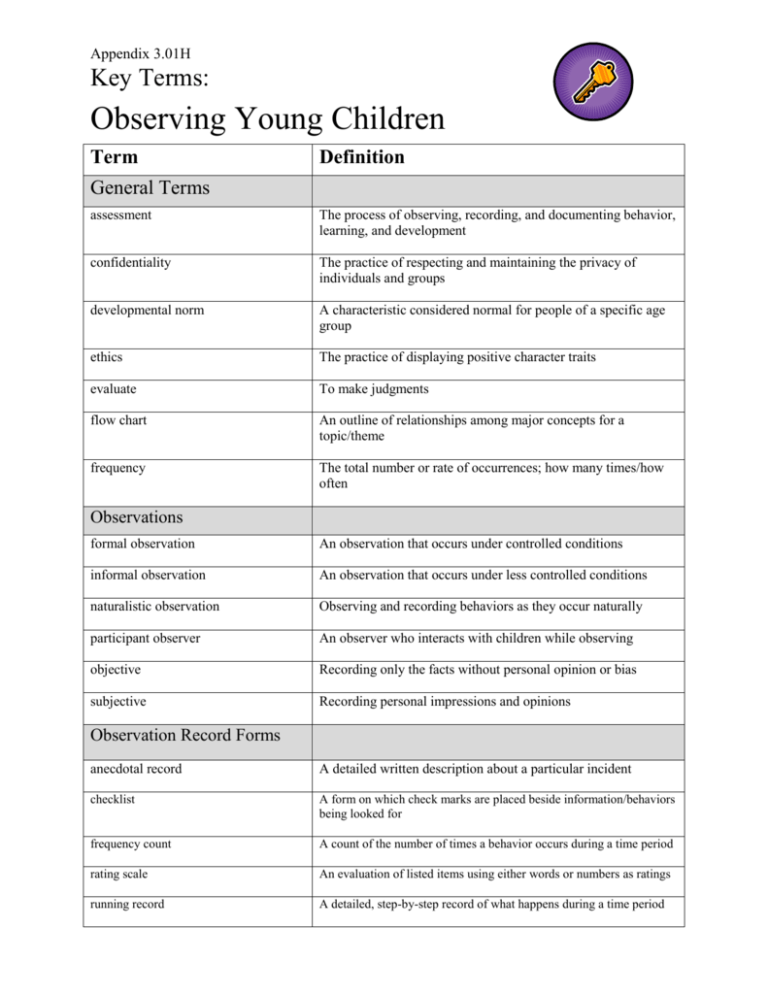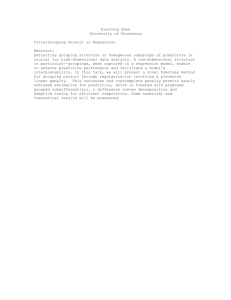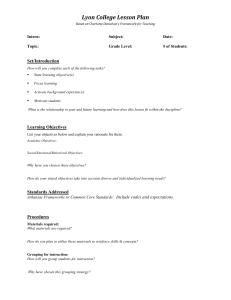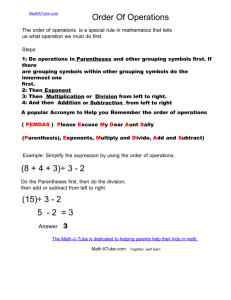Term Definition
advertisement

Appendix 3.01H Key Terms: Observing Young Children Term Definition General Terms assessment The process of observing, recording, and documenting behavior, learning, and development confidentiality The practice of respecting and maintaining the privacy of individuals and groups developmental norm A characteristic considered normal for people of a specific age group ethics The practice of displaying positive character traits evaluate To make judgments flow chart An outline of relationships among major concepts for a topic/theme frequency The total number or rate of occurrences; how many times/how often Observations formal observation An observation that occurs under controlled conditions informal observation An observation that occurs under less controlled conditions naturalistic observation Observing and recording behaviors as they occur naturally participant observer An observer who interacts with children while observing objective Recording only the facts without personal opinion or bias subjective Recording personal impressions and opinions Observation Record Forms anecdotal record A detailed written description about a particular incident checklist A form on which check marks are placed beside information/behaviors being looked for frequency count A count of the number of times a behavior occurs during a time period rating scale An evaluation of listed items using either words or numbers as ratings running record A detailed, step-by-step record of what happens during a time period Appendix 3.02H Key Terms: Teaching Young Children Term Definition General Terms concrete Tangible, having a visible shape or form environment Surroundings motor skills Skills that involve learning to use large and/or small muscles objective A statement of what is to be learned/accomplished in a learning activity passive Not participating, simply observing spontaneity The tendency to act on impulse, to let things happen naturally teachable moment A time when children are ready to learn teaching style The way in which a teacher conducts classes Play and Learning Materials closed-end materials Materials meant to be used in one way, with one intended outcome open-ended materials Materials that can be used in a variety of ways, with no one correct way to play with them manipulatives Toys/materials that children can touch, move, or change multi-purpose Able to be used in a variety of ways nontoxic Not poisonous, not harmful Ways Children Learn auditory Related to the sense of hearing; able to be heard visual Related to the sense of sight; able to be seen tactile Related to the sense of touch; able to be touched interactive Providing opportunities to explore and experiment role model A person who serves as a good example for others to imitate or learn from positive reinforcement Praise, encouragement, and other actions that strengthen a behavior Appendix 3.02H, continued Key Terms: Teaching Young Children Term Definition More Ways Children Learn modeling When a person shows another person how to do something sensory Relating to one or more of the five senses --- seeing, touching, hearing, smelling, and tasting sensory perception Use of the senses to take in and understand information Teaching Methods chronological grouping Grouping together children of the same age developmental grouping Grouping together children of the same ability levels family grouping Grouping together children according to their age ranges random grouping Grouping with no pattern in mind; each has an equal chance to be every group lesson plan A detailed, step-by-step record of what happens during a time period procedures The sequence of steps in a lesson plan or learning activity teaching technique A method used to help children learn transition A short activity or method for guiding children smoothly from one activity to another



